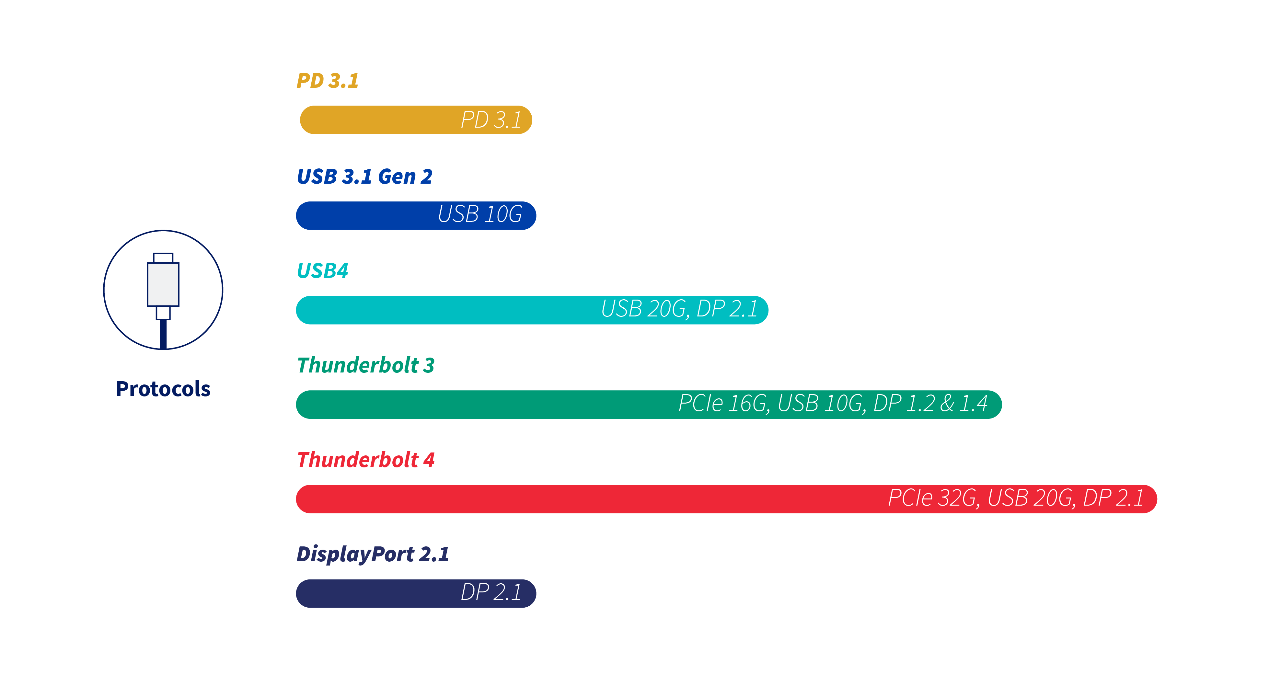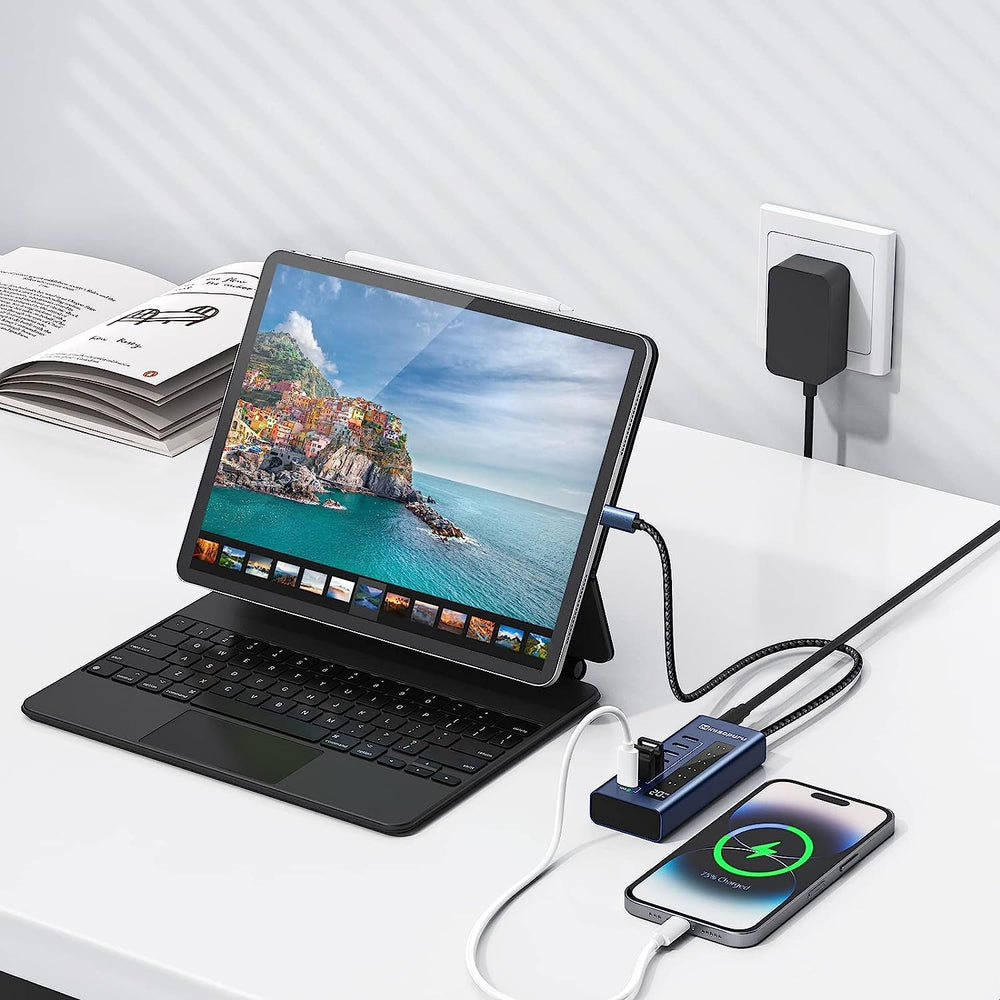On October 4, 2022, the European Union meeting officially announced USB Type-C® as a universal charging standard for small electronic devices. The universal standard aims to reduce electronic waste, improve product utilization, and make it more convenient for consumers. The EU universal charging will be launched in 2024. In addition to mobile phones, the devices it targets also include various small and medium-sized portable electronic devices such as tablets, e-readers, headsets, VR and AR. In 2023, Apple® will also replace its original Lightening interface products have all been upgraded to C-port, and the day when USB-C® interfaces will dominate the world is just around the corner.
Although various devices, cables, etc. all use the USB Type-C® interface, the technical applications are very different, which ultimately leads to different data transmission capabilities and audio and video performance capabilities. Do you really know the USB-C® interface?
USB Type-C® just refers to the application interface of the interface. The biggest appearance feature is that the upper and lower ends of the connector are exactly the same, and there is no distinction between the front and back sides of USB. Technical protocols such as USB4, Thunderbolt 3, Thunderbolt 4, USB Power Delivery (hereinafter referred to as PD), DisplayPort (hereinafter referred to as DP), etc. can all be built on the USB Type-C® interface. Since the Type-C interfaces on the market may not necessarily support all functions such as data transmission and audio and video transmission, consumers need to confirm detailed information with the salesperson when purchasing USB-C® products.
Taking the Type-C Host device interface as an example, the following figure shows its technical comparison and analysis.

Figure 1: Protocol comparison
Currently, the common Type-C interfaces on the market use PD, USB®, Thunderbolt, DP and other technologies. We briefly compiled a comparison between various technologies. PD technology and DP technology only have their own independent protocols (see Figure 1), while the latest USB4® technology has the most versatile Thunderbolt technology at present, and also includes PCIe, USB3.2, PD and DP protocols.

Figure 2: Audio and video transmission comparison
We can also understand the specific data transmitted by different technologies through the protocol layer. Since USB4® has the DP protocol layer, it can transmit audio and video, and Thunderbolt 4’s audio and video protocol is directly aligned with DisplayPort 2.1, so these two Both technologies can support audio and video playback on two 4K units or one 8K unit.

Figure 3: Data transfer rate comparison
When it comes to data transmission, USB4® can reach up to 20Gbps (this transfer rate is optional, so not every USB4 technology interface supports 20Gbps), while Thunderbolt 3 and Thunderbolt 4 can support up to 20.625Gbps data transfer (the The transmission rate is required, that is, each Thunderbolt 3 or 4 interface needs to support a rate of 20.625Gbps).
Through the analysis of the above three charts, we can observe that the PD protocol theoretically only supports charging. If it wants to have more functions, it needs to support other protocols.
3D (4K & HD)
Audio Return Channel (ARC) & HDMI Ethernet Channel (HEC) & Consumer Electronics Control (CEC)
High bandwidth digital content protection technology HDCP 1.4 & HDCP 2.2
Color depth (DeepColor) function and x.v.Color function

Figure 4: HDMI Alt Mode (Source: HDMI official website)
MHL Alt Mode can directly transmit video signals through the USB-C® physical interface, but it is basically limited to mobile phone applications. Since HDMI Alt Mode, MHL Alt Mode and VisualLink Alternate Mode have few practical application scenarios, this article will not discuss them for the time being.

Figure 5: Various technical signs
Generally speaking, terminal products will be marked with their functional logo on the Type-C® interface (refer to Figure 5). Users can purchase the product that best suits them based on their needs. Of course, you may also see different combinations of logos on the product, which means that the Type-C® port has multiple functions. The following is an MFDP (Multi-function DisplayPort) port, 4 pairs of lanes in the channel, It can be divided into two pairs of lanes to transmit DisplayPort, and two pairs of lanes to transmit USB data (this is the Pin Assignment D technology of the DP protocol), which means that the interface can not only transmit USB® data, but also audio and video signals.

Figure 6: MFDP logo
Google has also included a USB Type-C® cable reminder function in Chromebook OS updates to inform users whether the transmission cable fully matches the device requirements. The reminder includes whether the USB Type-C® cable used supports high-efficiency USB4®/Thunderbolt 3. In Win 10 and Win 11 computers, if you use an unsuitable USB® or Thunderbolt device/cable, you will also receive a notice from Billboard, such as: USB4® device functions may be limited.
Inexpensive cables also won’t support all the features USB Type-C® has to offer.
Although various devices, cables, etc. all use the USB Type-C® interface, the technical applications are very different, which ultimately leads to different data transmission capabilities and audio and video performance capabilities. Do you really know the USB-C® interface?
USB Type-C® just refers to the application interface of the interface. The biggest appearance feature is that the upper and lower ends of the connector are exactly the same, and there is no distinction between the front and back sides of USB. Technical protocols such as USB4, Thunderbolt 3, Thunderbolt 4, USB Power Delivery (hereinafter referred to as PD), DisplayPort (hereinafter referred to as DP), etc. can all be built on the USB Type-C® interface. Since the Type-C interfaces on the market may not necessarily support all functions such as data transmission and audio and video transmission, consumers need to confirm detailed information with the salesperson when purchasing USB-C® products.
Taking the Type-C Host device interface as an example, the following figure shows its technical comparison and analysis.
Figure 1: Protocol comparison
Currently, the common Type-C interfaces on the market use PD, USB®, Thunderbolt, DP and other technologies. We briefly compiled a comparison between various technologies. PD technology and DP technology only have their own independent protocols (see Figure 1), while the latest USB4® technology has the most versatile Thunderbolt technology at present, and also includes PCIe, USB3.2, PD and DP protocols.
Figure 2: Audio and video transmission comparison
We can also understand the specific data transmitted by different technologies through the protocol layer. Since USB4® has the DP protocol layer, it can transmit audio and video, and Thunderbolt 4’s audio and video protocol is directly aligned with DisplayPort 2.1, so these two Both technologies can support audio and video playback on two 4K units or one 8K unit.
Figure 3: Data transfer rate comparison
When it comes to data transmission, USB4® can reach up to 20Gbps (this transfer rate is optional, so not every USB4 technology interface supports 20Gbps), while Thunderbolt 3 and Thunderbolt 4 can support up to 20.625Gbps data transfer (the The transmission rate is required, that is, each Thunderbolt 3 or 4 interface needs to support a rate of 20.625Gbps).
Through the analysis of the above three charts, we can observe that the PD protocol theoretically only supports charging. If it wants to have more functions, it needs to support other protocols.
What is USB-C® Alt Mode?
USB-C Alt Mode, also known as USB Type-C Alternate Mode, is a feature of the PD protocol that allows USB-C® ports to transmit non-USB signals. As mentioned above, Thunderbolt 3 and Thunderbolt 4, DisplayPort 2.1 In addition to standard USB® functions such as USB® data transmission and power supply, USB-C® Alt Mode also supports the transmission of other protocols and signals through the same physical connector. The following are the current applications of Alternate Mode:- DisplayPort Alternate Mode
- Thunderbolt Alternate Mode
- VisualLink Alternate Mode
- HDMI Alternate Mode
- MHL Alternate mode
HDMI Alt Mode supports full HDMI 1.4b functionality:
4K resolution3D (4K & HD)
Audio Return Channel (ARC) & HDMI Ethernet Channel (HEC) & Consumer Electronics Control (CEC)
High bandwidth digital content protection technology HDCP 1.4 & HDCP 2.2
Color depth (DeepColor) function and x.v.Color function
Figure 4: HDMI Alt Mode (Source: HDMI official website)
MHL Alt Mode can directly transmit video signals through the USB-C® physical interface, but it is basically limited to mobile phone applications. Since HDMI Alt Mode, MHL Alt Mode and VisualLink Alternate Mode have few practical application scenarios, this article will not discuss them for the time being.
How do you distinguish the function of the USB Type-C® interface you see every day through its logo?
- Is there an SS logo next to the Type-C® connector? If yes, the interface supports data transmission function.
- Is there a Thunderbolt logo next to the Type-C® port? If so, the interface supports Thunderbolt 3 or Thunderbolt 4 functionality. You can use this interface for charging and data transmission. Since Thunderbolt contains DisplayPort Alt Mode, you can also transmit audio and video signals and connect the monitor directly.
- Is there a lightning logo next to the Type-C® port (note that the lightning and thunder logos are different)? If so, the interface only supports charging function.
- Is there a D (DisplayPort) logo next to the Type-C® connector? If there is, it means that the interface is a DPC interface and can support audio and video signal transmission.
Figure 5: Various technical signs
Generally speaking, terminal products will be marked with their functional logo on the Type-C® interface (refer to Figure 5). Users can purchase the product that best suits them based on their needs. Of course, you may also see different combinations of logos on the product, which means that the Type-C® port has multiple functions. The following is an MFDP (Multi-function DisplayPort) port, 4 pairs of lanes in the channel, It can be divided into two pairs of lanes to transmit DisplayPort, and two pairs of lanes to transmit USB data (this is the Pin Assignment D technology of the DP protocol), which means that the interface can not only transmit USB® data, but also audio and video signals.
Figure 6: MFDP logo
Common standard Type-C ecosystem compatibility is essential
Due to the diverse technologies of the Type-C® ecosystem, USB® certification, PD certification and Thunderbolt certification all include compatibility testing to ensure that after the product is launched, it will be compatible with most products on the market and improve user experience.Google has also included a USB Type-C® cable reminder function in Chromebook OS updates to inform users whether the transmission cable fully matches the device requirements. The reminder includes whether the USB Type-C® cable used supports high-efficiency USB4®/Thunderbolt 3. In Win 10 and Win 11 computers, if you use an unsuitable USB® or Thunderbolt device/cable, you will also receive a notice from Billboard, such as: USB4® device functions may be limited.
Inexpensive cables also won’t support all the features USB Type-C® has to offer.

